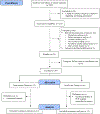A pilot school-based health center intervention to improve asthma chronic care in high-poverty schools
- PMID: 33322963
- PMCID: PMC8281495
- DOI: 10.1080/02770903.2020.1864823
A pilot school-based health center intervention to improve asthma chronic care in high-poverty schools
Abstract
Objective: To test the feasibility and effectiveness of a multifaceted intervention administered through school-based health centers (SBHCs) to improve asthma control for children in high-poverty schools with not well controlled asthma.
Methods: Students 4-14 years old with persistent asthma were enrolled from three SBHCs. The centers' advanced practice providers received training on evidence-based asthma guidelines. Students randomized to the intervention received directly observed therapy of their asthma controller medication, medication adjustments as needed by the centers' providers, and daily self-management support. Students randomized to usual care were referred back to their primary care provider (PCP) for routine asthma care.
Results: We enrolled 29 students. Students in the intervention group received their controller medication 92% of days they were in school. Ninety-four percent of follow-up assessments were completed. During the study, 11 of 12 intervention students had a step-up in medication; 2 of 15 usual care students were stepped up by their PCP. Asthma Control Test scores did not differ between groups, although there were significant improvements from baseline to the 7 month follow-up within each group (both p < .01). Both FEV1% predicted and FEV1/FVC ratio significantly worsened in the usual care group (both p = .001), but did not change in the intervention group (p = .76 and .28 respectively).
Conclusions: Our pilot data suggest that a multifaceted intervention can be feasibly administered through SBHCs in communities with health disparities. Despite the small sample size, spirometry detected advantages in the intervention group. Further study is needed to optimize the intervention and evaluate outcomes.
Trial registration: clinicaltrials.gov Identifier: NCT03032744.
Keywords: Pediatrics; children; chronic care model; directly observed therapy; health disparities; health services research; medication adherence; national guidelines; prevention; pulmonary function test; spirometry; treatment.
Conflict of interest statement
Figures






Similar articles
-
School-supervised use of a once-daily inhaled corticosteroid regimen: A cluster randomized trial.J Allergy Clin Immunol. 2019 Feb;143(2):755-764. doi: 10.1016/j.jaci.2018.06.048. Epub 2018 Aug 14. J Allergy Clin Immunol. 2019. PMID: 30118728 Free PMC article. Clinical Trial.
-
The effectiveness of school-based family asthma educational programs on the quality of life and number of asthma exacerbations of children aged five to 18 years diagnosed with asthma: a systematic review protocol.JBI Database System Rev Implement Rep. 2015 Oct;13(10):69-81. doi: 10.11124/jbisrir-2015-2335. JBI Database System Rev Implement Rep. 2015. PMID: 26571284
-
A pilot study to enhance preventive asthma care among urban adolescents with asthma.J Asthma. 2011 Jun;48(5):523-30. doi: 10.3109/02770903.2011.576741. J Asthma. 2011. PMID: 21599562 Free PMC article. Clinical Trial.
-
School-based self-management interventions for asthma in children and adolescents: a mixed methods systematic review.Cochrane Database Syst Rev. 2019 Jan 28;1(1):CD011651. doi: 10.1002/14651858.CD011651.pub2. Cochrane Database Syst Rev. 2019. PMID: 30687940 Free PMC article.
-
Improving Health Equity and Outcomes for Children and Adolescents: The Role of School-Based Health Centers (SBHCs).Curr Probl Pediatr Adolesc Health Care. 2024 Apr;54(4):101582. doi: 10.1016/j.cppeds.2024.101582. Epub 2024 Mar 14. Curr Probl Pediatr Adolesc Health Care. 2024. PMID: 38490819 Review.
Cited by
-
The role of supervised school therapy in poorly controlled asthma in children.Proc (Bayl Univ Med Cent). 2023 Apr 27;36(4):448-452. doi: 10.1080/08998280.2023.2204522. eCollection 2023. Proc (Bayl Univ Med Cent). 2023. PMID: 37334099 Free PMC article.
-
Social Determinants of Health and Health-Related Quality of Life Following Pediatric Septic Shock: Secondary Analysis of the Life After Pediatric Sepsis Evaluation Dataset, 2014-2017.Pediatr Crit Care Med. 2024 Sep 1;25(9):804-815. doi: 10.1097/PCC.0000000000003550. Epub 2024 Jun 5. Pediatr Crit Care Med. 2024. PMID: 38836691
-
Treating Childhood Obesity: Building and Evaluating Evidence-Based Models of Integrated Care.J Endocr Soc. 2025 Jun 13;9(8):bvaf109. doi: 10.1210/jendso/bvaf109. eCollection 2025 Aug. J Endocr Soc. 2025. PMID: 40599335 Free PMC article. Review.
-
School-based health: an area of opportunity to address challenges in management of pediatric obesity and type 2 diabetes.Curr Opin Pediatr. 2024 Feb 1;36(1):33-41. doi: 10.1097/MOP.0000000000001307. Epub 2023 Nov 17. Curr Opin Pediatr. 2024. PMID: 37975428 Free PMC article. Review.
-
Socioeconomic determinants of asthma health.Curr Opin Pediatr. 2023 Jun 1;35(3):337-343. doi: 10.1097/MOP.0000000000001235. Epub 2023 Mar 2. Curr Opin Pediatr. 2023. PMID: 36861771 Free PMC article. Review.
References
-
- Centers for Disease Control and Prevention. Asthma: Data, Statistics, and Surveillance [4/28/20]. Available from: www.cdc.gov/asthma/asthmadata.htm
Publication types
MeSH terms
Associated data
Grants and funding
LinkOut - more resources
Full Text Sources
Other Literature Sources
Medical
